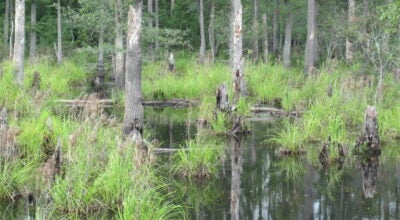Railroad chips in for swamp project
Published 10:56 pm Thursday, November 29, 2012

Fred Wurster, a hydrologist with the U.S. Fish and Wildlife Service, inspects a water-control structure installed as part of a large hydrologic restoration project at the Great Dismal Swamp National Wildlife Refuge. The project involved numerous partners including The Nature Conservancy and Norfolk Southern Foundation.
It’s hoped that new water-control structures in the Great Dismal Swamp National Wildlife Refuge will help restore environmental balance and minimize severe wildfires.
Installation of four of the metal structures in ditches southeast of Lake Drummond was completed Tuesday.
“They allow us to raise and lower the water level … by putting in or taking out flash boards,” refuge manager Chris Lowie said.
“We can put in 10 (boards) if we want water to be high, or six if we want water to be a little lower.”
Momentum to introduce more water into the swamp, drained by a series of ditches constructed by loggers in the 18th and 19th centuries, has been increasing after devastating wildfires in 2011 and 2008.
According to project partner The Nature Conservancy, the fires, which burned for weeks, lowered the swamp’s elevation by consuming the peat soils and had a combined price tag of $20 million.
Raising the water table in the swamp will reduce the incidence and severity of wildfires, which release large amounts of carbon into the atmosphere, said Brian van Eerden, the conservancy’s Southern Rivers Program director.
Van Eerden joined Lowie in praising the Norfolk Southern Foundation’s contribution of $25,000 toward two of the structures.
Lowie said, “We are very grateful for the contribution of Norfolk Southern” as well as other contributors to the $120,000-project, including the U.S. Environmental Protection Agency and the Virginia Department of Game and Inland Fisheries.
“We have been getting a lot of support for this more recently — in the last three years,” he added. “This work could not be done without the support of all our partners.”
Increasing water in the swamp will fight climate change by reducing the release of carbon during wildfires and encouraging new stands of trees that sequester carbon and help new layers of peat form, said van Eerden, who visited the swamp Tuesday.
“That is the contribution that the refuge is doing here to minimize the release of greenhouse gasses,” he said. “If the hydrology is right, there will be the opportunity for peat formation to resume.
“We need to increase the resiliency of the system in response to climate change. If we can restore the hydrology of the swamp, then we can establish the desirable forest communities that are out here, like Atlantic White Cedar.
“Here at the Great Dismal Swamp, the Norfolk Southern Foundation is supporting a project that has a lot of conservation benefits for not only nature, but people.”
Two water-control structures are under construction in ditches inside Dismal Swamp State Park, over the line in North Carolina, and the refuge is also paying for a fifth structure in Virginia, Lowie said.
To start with, he said, the structures’ board system will be adjusted to introduce “as much water as we can without having an actual negative impact” such as submerging roads that run atop the banks above ditches.
A series of wells throughout the refuge, which form what Lowie described as a large groundwater-monitoring network, will provide information for the system to be tweaked as needed.
Encouraged by the Norfolk Southern Foundation’s generosity, the conservancy is on the lookout for additional funding to expand water management infrastructure in the swamp, van Eerden said.
“We are making very satisfying steps in that direction,” he said. “The way forward is to try to find the resources to put together a comprehensive plan.”
“The Norfolk Southern Foundation is proud to partner with The Nature Conservancy in restoring this important natural resource,” Blair Wimbush, Norfolk Southern vice president real estate and corporate sustainability officer, stated in a press release.
“We are committed to carbon sequestration and preservation of important wildlife habitat. Improving water flow in the Great Dismal Swamp is a positive step for the health of the ecosystem and for local air quality.”






